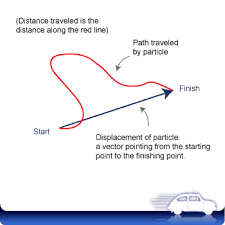How does the Distance travelled by a body differ from its Displacement
We have seen that the distance travelled by a body differs
from its displacement in certain respects. These differences are given in
Table.

| Distance 1. The distance travelled by a moving body is the actual length of the path covered by the body, irrespective of the direction. 2. Distance travelled is a scalar quantity. 3. Distance traveled is always positive, negative or zero. 4. Distance travelled is always greater than or equal to the displacement. |
Displacement 1. The displacement of a body is the shortest distance between the initial and the final position of the body. 2. Displacement is a vector quantity. 3. Displacement may be positive. 4. Displacement is always less than or equal to the distance travelled. |

When do the
distance travelled and the displacement become equal?
If a body moves along a straight line in its positive
direction, then its displacement and the distance travelled by it are equal and
have the same sign.
1. Example: A body thrown vertically upward
rises up to a height h, and comes back to the initial position. Calculate (a)
the total distance travelled by the body, (b) the displacement of the body.
Solution- The body
thrown vertically up rises up to a height h, and then returns to its initial
position.
(a) The total
distance travelled = h + h = 2h
(b) The body
returns to its initial state. So, the initial and final positions coincide with
each other.
Therefore, Displacement of the body = 0 (zero)
2. Example: Ravi told his friend that his
house is 1 km toward south from the Main post office. Express displacement and
the distance moved by the friend from the Post Office when he arrives at Ravi’s
house. Mention the reference point chosen by you.
Solution-
Reference point: Main Post Office
Distance moved by the
Ravi’s friend = 1 km
As per convention, the direction of south
is taken as negative. So,
Displacement of the Ravi’s
friend = -1 km
3. Example:
Two cars moving in opposite direction cover same distance d in one hour. If the
cars were moving in north-south direction, what will be their Displacement in
one hour?
Solution-
Assuming the two cars are moving in the opposite directions from the same point
Distance moved by each car in 1h
= d
After 1 h,
Displacement of the cars
relative to each other = d + d = 2d
Displacement of car 2 (moving north)
relative to the initial position = + d





This blog is worth sharing. Thanks. We, the The True Indians based in Delhi and Bangalore, we promote businesses and generate sales that help you take your business to the next level. Please go through our blog to get some amazing posts to read. Thanks
ReplyDeleteAlcohol Brands in India
Vodka Brands in India
Best Rum Brands in India
Indian mobile phone companies
Indian breed dogs
LONGEST SNAKE IN THE WORLD
ALL POKEMON CHARACTERS
FAMOUS POKEMON CHARACTERS
Famous Cartoon Characters
Made in india laptop company
HIGHEST MOUNTAIN PEAK IN SOUTH INDIA
BEST GAMING NAMES
Lip Kiss
National Parks in India
Oxygen Producing Plants
Doraemon Cartoon Characters
All Country Code Number
Ninja Hattori Characters Names